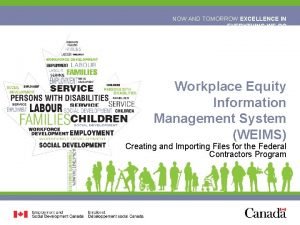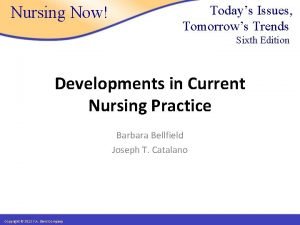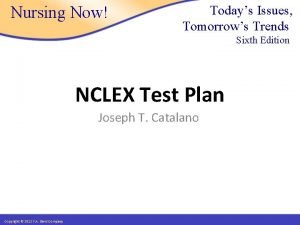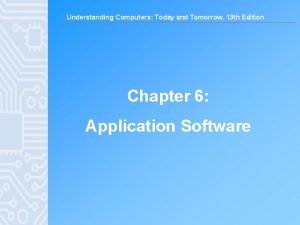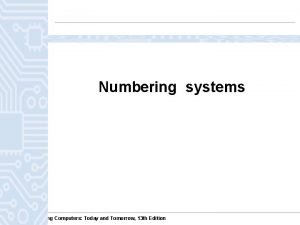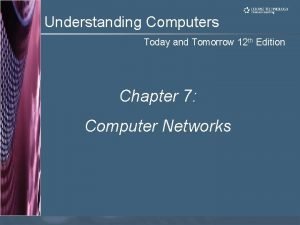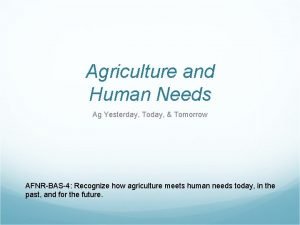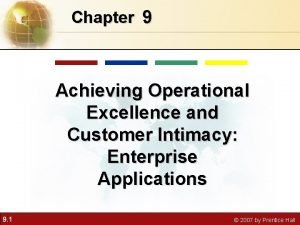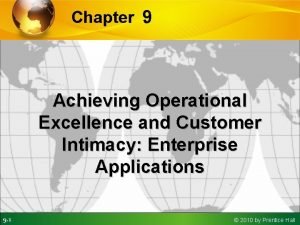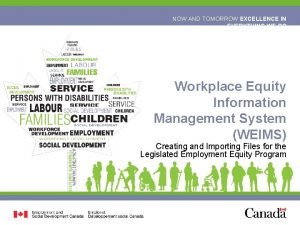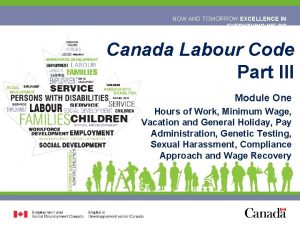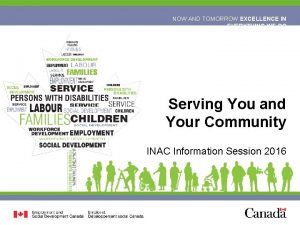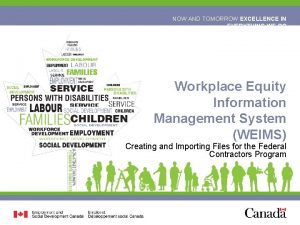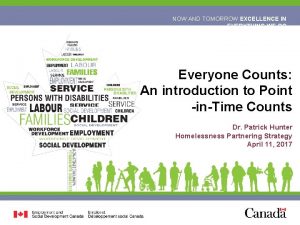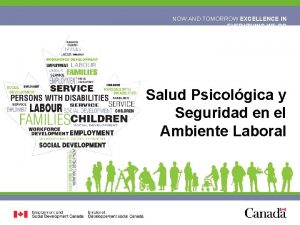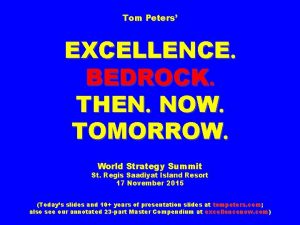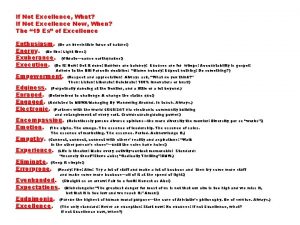1 NOW AND TOMORROW EXCELLENCE IN EVERYTHING WE































- Slides: 31

1 NOW AND TOMORROW EXCELLENCE IN EVERYTHING WE DO Everyone Counts: An introduction to Point -in-Time Counts Dr. Patrick Hunter Homelessness Partnering Strategy April 11, 2017

2 NOW AND TOMORROW EXCELLENCE IN An Introduction to Pi. T Counts EVERYTHING WE DO Outline 1. What is a Pi. T Count? a) b) Purpose of a count A common approach 2. Available Resources 3. Where to begin: The steps involved in a count a) b) Lessons learned: Advice from communities Major decisions on the local approach 4. HPS Coordinated Pi. T Counts a) b) Recap of the 2016 Coordinated Pi. T Count Everyone Counts! Pi. T 2018 c) Next Steps

3 NOW AND TOMORROW EXCELLENCE IN An Introduction to Pi. T Counts EVERYTHING WE DO Purposes of a Pi. T Count On a typical night: 1. How many people are experiencing homelessness? 2. Who is experiencing homelessness? Enumeration Survey • Sheltered • Unsheltered • Demographics • Service Needs

4 NOW AND TOMORROW EXCELLENCE IN An Introduction to Pi. T Counts EVERYTHING WE DO Purposes of a Pi. T Count When repeated over subsequent years, Pi. T counts can measure changes in the size and nature of the population.

5 NOW AND TOMORROW EXCELLENCE IN An Introduction to Pi. T Counts EVERYTHING WE DO Implementation • Survey teams conduct survey and count within a 24 -hour period (typically). • At a minimum, the count includes shelters and outdoor known locations, but may be expanded. Service Locations Magnet Event(s) Public Spaces Shelters Transitiona l Shelters

6 NOW AND TOMORROW EXCELLENCE IN The HPS Pi. T Count Approach EVERYTHING WE DO Overview • Core Populations to be included in the count across all communities. • A set of Core Screening and Survey Questions that will be common across communities. Communities may include additional survey questions to address local information needs. • A set of Core Standards for participation in the count, as well as Recommended Standards that are good practices, but not mandatory.

7 NOW AND TOMORROW EXCELLENCE IN The HPS Pi. T Count Approach EVERYTHING WE DO Methodology: Core Populations Unsheltered (Core) Sleeping rough on the street, in parks, camps, vehicles or abandoned buildings Sheltered (Core) Emergency shelters, VAW shelters, or hotel vouchers in lieu of a shelter bed Transitional (Core) Transitional shelters, providing longer stays intended to transition the client to permanent housing. Systems (Optional) Corrections: prisons, jails, detention centres with no fixed address Health: hospitals, detox, other treatment facilities with no fixed address Hidden (Optional) Staying with someone else because the person is without a place of his or her own

8 NOW AND TOMORROW EXCELLENCE IN The HPS Pi. T Count Approach EVERYTHING WE DO Methodology: Core Questions Overnight location Ø Ø Family members Age of first homelessness Length of homelessness in the past Ø year Ø Ø Number of episodes in the past Ø year Ø Ø Shelter use in the past year Ø Ø Length of time in the community Ø Ø Ø Migration from… Indigenous identity Newcomer status Ø Length of time in Canada Veteran status Age Gender identity Sexual orientation (identity) Reasons for housing loss Income sources

9 NOW AND Workspace TOMORROW EXCELLENCE IN Available Supports: Community EVERYTHING WE DO www. workspaceonhomelessness. ca/pitcounts “Home page” for the Coordinated Pi. T Counts • Ask-Me-Anything/Town Hall sessions • Volunteer training materials • National and community Pi. T count reports • Training videos

10 NOW AND TOMORROW EXCELLENCE IN Available Supports: Pi. T Count Guide EVERYTHING WE DO www. canada. ca/en/employment-socialdevelopment/programs/communities/homelessness/reports/guide-point-in-time-counts. htm • Core and Recommended Standards • Methodology, including Core Screening and Survey Questions • Implementation timeline • Guidance for: – developing the local approach – conducting the survey – preparing for after the count

11 NOW AND TOMORROW EXCELLENCE IN Available Supports: Pi. T Count Toolkit EVERYTHING WE DO Canadian Observatory on Homelessness www. homelesshub. ca/pitcounttoolkit • Customizable templates for key documents such as a Pi. T Count Coordinator job description, volunteer forms, a shelter enumeration form template. • A list of optional Pi. T Count survey questions. • Guidance on partnering with Indigenous communities throughout planning and implementation. • Recommendations on improving the representation of youth.

12 NOW AND TOMORROW EXCELLENCE IN An Introduction to Pi. T Counts EVERYTHING WE DO Implementation Timeline

13 NOW AND TOMORROW EXCELLENCE IN Pi. T Count Implementation Timeline EVERYTHING WE DO Planning 4+ Months before the Count Form a Local Pi. T Count Committee • Members should include: Homelessness coalitions (e. g. , HPS CAB, CE), municipality, the Indigenous community, the homelessness services sector, community homelessness data coordinators, emergency services, people with lived experience. • Subcommittees may consider specific aspects of the count (e. g. , survey questions, methodology, volunteer recruitment). Identify a Pi. T Count Coordinator (and assistant coordinators) • Someone closely connected with the local homelessness-services sector and have a background coordinating community projects. • Range of duties will vary by community size. Assistant coordinators may support particular aspects of the count (and may chair subcommittees).

14 NOW AND TOMORROW EXCELLENCE IN Pi. T Count Implementation Timeline EVERYTHING WE DO Planning (continued) 4+ Months before the Count Reach out to the Community • Develop a communication strategy to engage community and media. • Announce intention to participate early. Reach out early to build community awareness of the count and to lay the groundwork for recruiting volunteers. • Local businesses may be interested in supporting the count through sponsoring the count or providing donations (e. g. , items for survey respondents, food for volunteers, etc. ). • Consult key stakeholders on aspects of the count where you have some flexibility (e. g. , additional questions, honoraria for survey respondents, etc. ). This should include people with lived experience.

15 NOW AND TOMORROW EXCELLENCE IN Pi. T Count Implementation Timeline EVERYTHING WE DO Preparation 1 - 4 Months before the Count Define the Local Implementation • Consult Pi. T Count Committee on a survey strategy. Identify scope of the count and all survey areas. The local approach will vary greatly by community. • Finalize the survey. Determine whether to build on to the Core Questions. Keep the survey short - Each question should have a specific purpose related to planning or resource allocation. • Consider whether to add to the Core Populations (e. g. , by including hidden homelessness). • Decide between overnight and next-day unsheltered counts.

16 NOW AND TOMORROW EXCELLENCE IN Pi. T Count Implementation Timeline EVERYTHING WE DO Preparation (continued) 1 - 4 Months before the Count Recruit Volunteers • From: service organizations and local community groups (e. g. , Student groups, Religious communities, Business Improvement Associations, Unions, etc. ). • Roles: survey teams, coordination on the night of the count, and data entry after the count, etc. Prepare a Plan for the Night of the Count • Central headquarters for coordinating the count, potentially regional hubs. Develop a system for organizing and inputting incoming surveys. • Determine: what your survey teams will look like, what resources you will need. • Develop a plan for organizing and inputting incoming surveys.

17 NOW AND TOMORROW EXCELLENCE IN Pi. T Count Implementation Timeline EVERYTHING WE DO Implementation Less than 1 Month before the Count Train Survey Volunteers • Timing of training: in advance or day-of. • Topics: – – – how to approach people in a respectful way, how to ask the screening questions and who should be screened in and out, how to ask the survey questions and what information they are looking for, how to fill the survey form, and how to request assistance if required. • Training can be an opportunity to educate the public, but keep the information practical and relevant to the count. There is a lot of information that volunteers need to be prepared for the experience. • Keep in close contact with volunteers leading up to the count.

18 NOW AND TOMORROW EXCELLENCE IN Pi. T Count Implementation Timeline EVERYTHING WE DO Implementation (continued) Less than 1 Month before the Count Final Preparation • Prepare survey maps for the survey teams (city planning departments may be able to help to develop these). • Purchase supplies and prepare kits for survey teams (e. g. , clipboards with surveys, map, honoraria). • Form an outreach/emergency services team: may be need for emergency services or shelter. Team(s) quickly address these needs on the night of the count. • Deliver survey kits and other supplies to shelters, area headquarters, etc.

19 NOW AND TOMORROW EXCELLENCE IN Pi. T Count Implementation Timeline EVERYTHING WE DO Day of the Count • The day of the count will look different depending on the local implementation of the methodology. • Generally: – volunteers arrive before their shift for a last minute refresher (or training session); – survey team leaders bring (walk or drive) their teams to the survey location or route; – headquarters volunteers and staff manage incoming and outgoing teams, provide them with kits, track honoraria, and receive surveys; – someone should be on hand to review the incoming survey forms with the survey teams, although well-trained team leaders can also serve this function. • Resources: www. workspaceonhomelessness. ca/pitcounts

20 NOW AND TOMORROW EXCELLENCE IN Pi. T Count Implementation Timeline EVERYTHING WE DO Post-Count 1+ Days After Enter Count Data and Survey Responses • This is best done the day after the count, since it will be easier to address any ambiguity in the forms while the count is still fresh. • Identify a volunteer team to enter surveys and review the data. • HIFIS 3 and 4 can be used to enter survey responses, export data, and generate basic reports. • Confidentiality. Analyze Results (and Submit to HPS) • Ideally, capacity to conduct statistical analyses helps. It may be possible to partner with a nearby university or college. • However, data from a first count is largely descriptive and can be done in a spreadsheet application. • HIFIS can export the data to the HPS. Doing so contributes to the national understanding of homelessness.

21 NOW AND TOMORROW EXCELLENCE IN Pi. T Count Implementation Timeline EVERYTHING WE DO Post-Count (continued) 1+ Days After Communicate with the Community • Findings can be communicated through press releases, infographics, reports, webpages, etc. It’s also helpful to speak about how the results are being used to help the population. • Communicating the results will help to maintain community engagement on the count and support for future counts. • Specific strategy to communicate with the homeless population. Prepare for the Next Count • Consider the lessons-learned from the count and what could be improved for the next count. Include a survey of volunteers to get a range of perspectives.

NOW AND TOMORROW EXCELLENCE IN An Introduction to Pi. T Counts EVERYTHING WE DO 22 Some lessons learned • Write everything down. What decisions were made and why. • Starting early allows more time for consultation, including people with lived experience. It can improve the quality of the count and community buy-in. • Assistant Coordinators are needed for most community counts and are particularly helpful for managing volunteers close to the count date. • Surveyors should understand what populations you are trying to screen-in to the survey and what information the questions are meant to provide. • Surveyors should review their forms with volunteers as they are come in to clarify any ambiguities on the spot. • Budget for data analysis and report writing – consider seeking partnerships with universities or colleges.

NOW AND TOMORROW EXCELLENCE IN An Introduction to Pi. T Counts EVERYTHING WE DO 23 (Some) Major Decisions • Pi. T Count Committee membership? Structure? • Overnight vs. next day unsheltered count • Known locations vs. sampling approach • What is appropriate to give for honoraria? • What questions to add? • Core Populations only? Systems? Hidden Homelessness? • Enhanced approaches – Registry Week? Youth count?

24 NOW AND TOMORROW EXCELLENCE IN An Introduction to Pi. T Counts EVERYTHING WE DO Pi. T Count + Registry Week • Registry Week: multiple days of data collection using VISPDAT and demographic questions. • In 2016, eight communities conducted a combined Pi. T Count + Registry Week • The first day is a full Pi. T Count day, however surveys continue over additional days to continue to build the registry. • Combined survey tool developed in collaboration between HPS and the Canadian Alliance to End Homelessness.

25 NOW AND TOMORROW EXCELLENCE IN HPS Coordinated Pi. T Counts EVERYTHING WE DO

26 2016 HPS Pi. T Count NOW AND TOMORROW EXCELLENCE IN EVERYTHING WE DO First count: January 16 Last count: April 25 32 Participating Communities 2000+ Volunteers 250+ Shelters and Transitional facilities 350+ Community Partners Ontario 13 communities West 11 communities East 8 communities

27 2016 HPS Pi. T Count Some Key Findings NOW AND TOMORROW EXCELLENCE IN EVERYTHING WE DO https: //www. canada. ca/content/dam/canada/employment-socialdevelopment/programs/communities/homelessness/reports/highlights/Pi. T-Doc. pdf • On any particular day, over 50% of the homeless population has been experiencing chronic homelessness. • 25% did not use a shelter over the past year. • Homelessness spikes in the mid-to-late teens, dropping off for women in their mid-20 s and men in their 50 s. • Nearly 1 in 3 youth cite conflict with a parent or guardian as contributing to their most recent homelessness. • Seniors and older adults are more likely to cite financial factors for their most recent housing loss. • Overrepresented populations: Indigenous people (9 x) and veterans (2 x) • Newcomers represented were more likely to be homeless as a family.

28 EXCELLENCE IN EVERYONE COUNTS! 2018 NOW AND TOMORROW EVERYTHING WE DO The Next Coordinated Count When? March / April 2018 Who can participate? HPS designated communities will be eligible for support, although any community can participate and contribute to the national picture.

29 Everyone Counts! 2018 NOW AND TOMORROW EXCELLENCE IN EVERYTHING WE DO Benefits of participating in the Coordinated Pi. T Count • Contributes to the national understanding of homelessness • More data is particularly important to understand the experiences of smaller population groups (e. g. , newcomers, LGTBQ 2 S) • Supports and tools are available and easily accessible • HIFIS 3 and 4!

30 Everyone Counts! 2018 Next Steps NOW AND TOMORROW EXCELLENCE IN EVERYTHING WE DO May 2017 • Ask-me-anything on the Community Workspace on Homelessness Spring – Fall 2017 • Further training materials for volunteers • Further Webinars / Town Halls / Ask-Me-Anything Sessions • Coordinator Training

31 Everyone Counts! 2018 NOW AND TOMORROW EXCELLENCE IN EVERYTHING WE DO Thank you! Questions? Comments? Patrick Hunter patrick. hunter@hrsdc-rhdcc. gc. ca 819 -654 -2247 Resources Guide www. canada. ca/en/employment-socialdevelopment/programs/communities/homelessness/reports/guide-point-in-time-counts. html Toolkit www. homelesshub. ca/pitcounttoolkit Workspace www. workspaceonhomelessness. ca
 Tomorrow shakespeare
Tomorrow shakespeare Tomorrow and tomorrow and tomorrow kurt vonnegut analysis
Tomorrow and tomorrow and tomorrow kurt vonnegut analysis Due tomorrow do tomorrow
Due tomorrow do tomorrow Due tomorrow do tomorrow
Due tomorrow do tomorrow Excellence in everything we do
Excellence in everything we do Nursing now today's issues tomorrow's trends
Nursing now today's issues tomorrow's trends Nursing now today's issues tomorrow's trends
Nursing now today's issues tomorrow's trends Now i see it now you don't
Now i see it now you don't Yesterday
Yesterday Romeo and juliet act 3 scene 3 summary
Romeo and juliet act 3 scene 3 summary Computer today and tomorrow presentation
Computer today and tomorrow presentation Computer today and tomorrow
Computer today and tomorrow Understanding computers today and tomorrow
Understanding computers today and tomorrow Same today tomorrow and forever
Same today tomorrow and forever Marketing today and tomorrow chapter 1
Marketing today and tomorrow chapter 1 Agriculture- yesterday today and tomorrow
Agriculture- yesterday today and tomorrow Casting crowns who am i
Casting crowns who am i Tomorrow's technology and you
Tomorrow's technology and you Tomorrow's technology and you
Tomorrow's technology and you Tomorrow's technology and you
Tomorrow's technology and you Achieving operational excellence and customer intimacy
Achieving operational excellence and customer intimacy Achieving operational excellence and customer intimacy
Achieving operational excellence and customer intimacy Spreading excellence and widening participation
Spreading excellence and widening participation Respect integrity communication and excellence
Respect integrity communication and excellence Cost excellence and inclusiveness policy
Cost excellence and inclusiveness policy Widening participation and spreading excellence
Widening participation and spreading excellence Teaching excellence and achievement
Teaching excellence and achievement Equity and excellence liberating the nhs
Equity and excellence liberating the nhs Equity and excellence liberating the nhs
Equity and excellence liberating the nhs What is the answer to life the universe and everything
What is the answer to life the universe and everything Matter is anything that occupies space and has mass
Matter is anything that occupies space and has mass Everything that surrounds us is called
Everything that surrounds us is called




